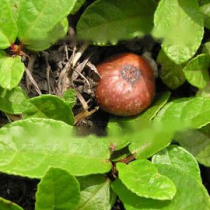
Chinese name: Dipomegranate
Latin name: Ficus tikouaBur.
Alternative names: Diguo, Dipipa, Dipomegranate, sweet potato
Family: Moraceae
Distribution area: Yunnan, Tibet, Sichuan, Guizhou, Guangxi, Hunan, etc.
1. Morphological characteristics of pomegranate
Pomegranate is a creeping woody vine, with adventitious roots on the stems running horizontally, brownish with more swelling in the internodes. The leaves are alternately hard and papery, obovate-elliptic, acuminate or obtusely rounded at the apex, rounded to shallowly heart-shaped at the base, wavy sparsely serrated on the edge, undulating with reticulate folds on the surface, short petioles, and obvious midrib. Flowers are found on the inner wall of figs. The fruiting period is in summer. The figs grow in pairs or clusters on stolons, often buried in the soil. They are spherical to ovoid, with pale white spots on the surface and slightly convex scars on the top. Red, edible fruit.
2. Habits of Pomegranate
Pomegranate is generally wild and can adapt to full sun. It prefers the growth environment with sufficient light and humidity. If the light is insufficient, the leaves of the plant are sparse and the rhizomes are leggy. The optimum temperature for growth is 16°C to 28°C. It is not cold-resistant. The plants stop growing at low temperatures. In case of frost in winter, the leaves dry up, and the rhizomes overwinter underground. Drought-resistant, the plants are not easy to lose water in the dry season, and grow well in the high temperature environment in summer. It has strong adaptability and does not have strict requirements on soil, and usually does not choose soil. Semi-shade-tolerant, likes humidity
3. The effect of pomegranate
Pomegranate is harvested in spring and summer and its rhizomes are dried and used as medicine. , The effect of promoting blood circulation and detoxification, as long as the auxiliary treatment for the treatment of jaundice, scrofula, unknown swelling and pain, rheumatism pain, diarrhea, dysentery, hemorrhoid bleeding and other diseases, it is generally taken orally, and an appropriate amount of decoction is taken. In addition, the fruit can be eaten directly, with a sweet taste and full of water. The fruit has a male and a female. Generally, the male and female ones do not have water. When eating, wash them with water and remove the stalk scars on both ends. The fruit matures in summer.
Guess you like it
Codonopsis ginseng |Vine|Iron sandals|Spotted pink flower Lingxiao|
Inverted leaf shield-winged vine|Ruby taro|Triangular leaf passionflower|Trilobite SnakeGrape|Green Emperor|Sparrow Flower|Mallow Mallow|Wood Rose|Polygonum vines|
Milk Vine| Cymbal Flower| | Qing rattan | Mountaintortoise| Snake King rattan|Tree morning glory|
Waer rattan| Wangfei rattan| Brilliant W Tong | Night Fragrant Flower | Eagle Claw Flower | Bright Night | Purple Cicada Flower |
![[Dog Training 5] The training method of pet dog dining etiquette](/static/img/12192/12192_1.jpg)




